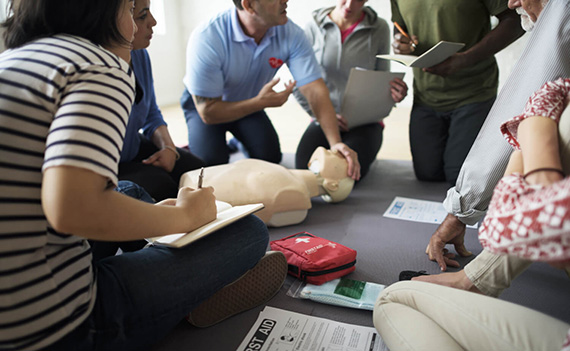Emergency First Aid at Work
Delivery methods available:
Face-to-face

Duration
1 Day
Time
9.30am - 4.30pm
Cost
£95 (+VAT)
Emergency First Aid Reviews
Upcoming Courses
FAQs about Emergency First Aid at Work
What is Emergency First Aid at Work training?
Emergency first aid training is a one-day course. It aims to equip employees with the knowledge and practical skills to deal with emergency situations in the workplace. The qualification provides training to the standard required by the Health and Safety (First Aid) Regulations, the HSE, and the HSENI. Organisations often use the training to upskill employees to operate in a supportive role to the 3-day qualified first aider. However, where the level of risk is identified as low, it may be deemed a sufficient level of cover.
What does it cover?
The Emergency First Aid at Work course has a single mandatory unit. The initial part of the course focuses on preparing the delegate for their role. To do this, the trainer covers fundamental content focused on the remit and boundaries of the role. In addition, other important aspects are covered, such as infection control and consent.
The course's mid-section explores first aid treatment for severe and potentially life-threatening conditions. This content prepares the delegate to act effectively in a medical emergency within the workplace. The learner will be required to apply practical techniques such as CPR, the recovery position and choking intervention. Other interventions that the learner will be required to demonstrate are controlling external bleeding and shock cases.
The latter part of the course focuses on minor injuries. This section aims to ensure that the first aider can provide effective treatment where employees sustain minor injuries within the workplace that do not require emergency intervention.
Syllabus
- Role and responsibilities of a first aider
- Assessing an incident
- First aid for an unresponsive casualty (Includes CPR and the use of an AED)
- First aid for choking
- First aid for external bleeding
- First aid for shock
- First aid for minor injuries
How is an Emergency First Aid at Work course assessed?
Emergency first aid training is assessed in two parts. First, there are four mandatory practical application assessments and then a multi-choice theory-based examination. The practical assessments require the delegate to demonstrate CPR and the safe use of an AED. It also requires the learner to apply the correct practical application of first aid treatment for a choking, unconscious, bleeding, and shock casualty. In addition, delegates are provided with 25 minutes at the end of the course to complete the 15-mark multi-choice assessment, which addresses theory content covered during the training day.
How long does it take?
Emergency first aid involves 6 hours of trainer-trainee contact. The content is most frequently delivered in a single day. Typically, courses commence at 9.30 am and are completed at 4.30 pm. Variations to these timings can be offered to suit business needs. The course is highly interactive and largely practical-focused. This delivery approach results in an enjoyable training experience.
Who needs an Emergency First Aid at Work course?
This course is appropriate for anyone sixteen or over who may be required to provide first aid provision within the workplace environment. It is ideal for low-risk workplaces whose management has assessed and determined a need for basic first aid cover. It can also benefit large sprawling workplaces where the fully qualified first aider may not always be readily available. In such instances, it may be appropriate to provide the initial first aid cover and then support the three-day qualified first aider on arrival.
Why is it important?
Workplace first aid provision is a legal requirement. Employers have a legislative responsibility to ensure that adequate first-aid resources exist within the workplace. Despite advancements in health and safety standards, accidents still exist. Therefore, trained individuals must be at hand to effectively deal with emergencies until further help arrives. This course can ensure that employers meet their legal and moral obligations to safeguard their employees.